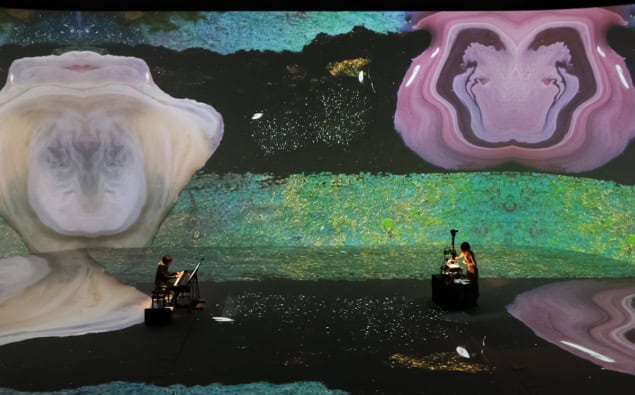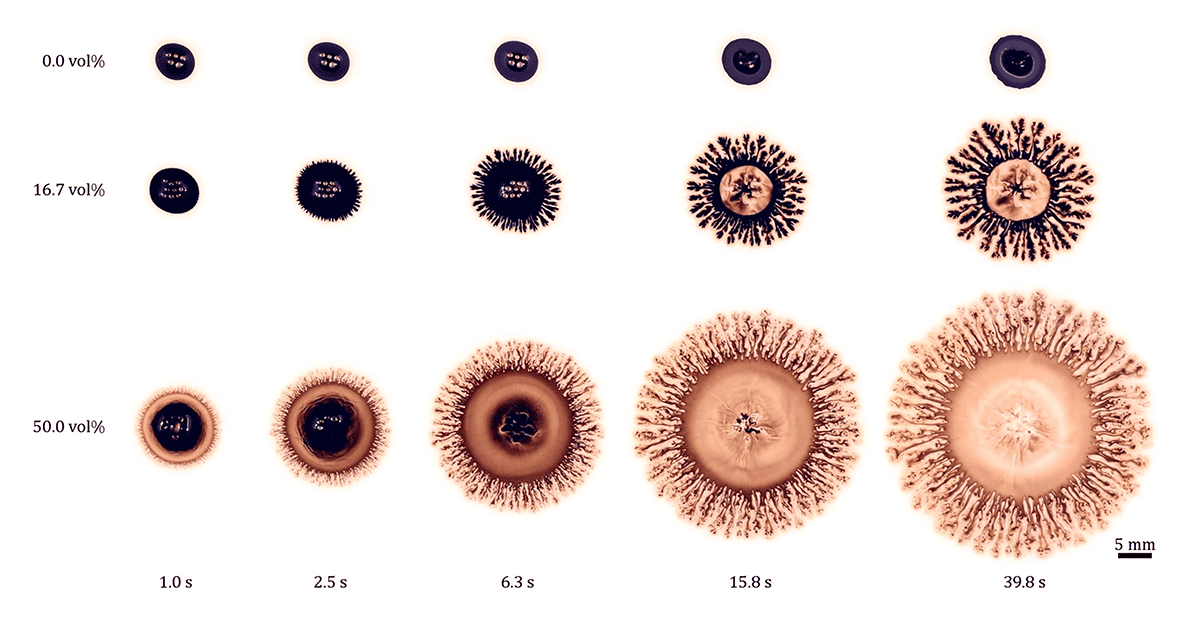Most paintings are static images created by artists in private. Sidney Perkowitz explores the work of Akiko Nakayama, who uses her feel for the behaviour of fluids to create beautiful dynamic pictures in front of live audiences

Any artist who paints is intuitively an expert in empirical fluid mechanics, manipulating liquid and pigment for aesthetic effect. The paint is usually brushed onto a surface material, although it can also be splattered onto a horizontal canvas in a technique made famous by Jackson Pollock or even layered on with a palette knife, as in the works of Paul Cezanne or Henri Matisse. But however the paint is delivered, once it dries, the result is always a fixed, static image.
Japanese artist Akiko Nakayama is different. Based in Tokyo, she makes the dynamic real-time flow of paint, ink and other liquids the centre of her work. Using a variety of colours, she encourages the fluids to move and mix, creating gorgeous, intricate patterns that transmute into unexpected forms and shades.
What also sets Nakayama apart is that she doesn’t work in private. Instead, she performs public “Alive painting” sessions, projecting her creations onto large surfaces, to the accompaniment of music. Audiences see the walls of the venue covered with coloured shapes that arise from natural processes modified by her intervention. The forms look abstract, but in their mutations often resemble living creatures in motion.
Inspired by ink
Born in 1988, Nakayama was trained in conventional techniques of Eastern and Western painting, earning degrees in fine art from Tokyo Zokei University in 2012 and 2014. Her interest in dynamic art goes back to a childhood calligraphy class, where she found herself enthralled by the beauty of the ink flowing in the water while washing her brush.
“It was more beautiful than the characters [I had written],” she recalls, finding herself “fascinated by the freedom of the ink”. Later, while learning to draw, she always preferred to capture a “moment of time” in her sketches. Eventually, Nakayama taught herself how to make patterns from moving fluids, motivated by Johann Wolfgang von Goethe’s treatise Theory of Colours (1810).
Best known as a writer, Goethe also took a keen interest in science and his book critiques Isaac Newton’s work on the physical properties of light. Goethe instead offered his own more subjective insights into his experiments with colour and the beauty they produce. Despite its flaws as a physical theory of light, reading the book encouraged Nakayama to develop methods to pour and agitate various paints in Petri dishes, and to project the results in real time using a camera designed for close-up viewing.

She started learning about liquids, reading research papers and even began examining the behaviour of water droplets under strobe lights. Nakayama also looked into studies of zero gravity on liquids by JAXA, the Japanese space agency. After finding a 10 ml sample of ferrofluid – a nanoscale ferromagnetic colloidal liquid – in a student science kit, she started using the material in her presentations, manipulating it with a small, permanent magnet.
Nakayama’s art has an unexpected link with space science because ferrofluids were invented in 1963 by NASA engineer Steve Papell, who sought a way to pump liquid rocket fuel in microgravity environments. By putting tiny iron oxide particles into the fuel, he found that the liquid could be drawn into the rocket engine by an electromagnet. Ferrofluids were never used by NASA, but they have many applications in industry, medicine and consumer products.
Secret science of painting
Having presented dozens of live performances, exhibitions and commissioned works in Japan and internationally over the last decade, other scientific connections have emerged for Nakayama. She has, for example, mixed acrylic ink with alcohol, dropping the fluid onto a thin layer of acrylic paint to create wonderfully intricate branched, tree-like dendritic forms.
In 2023 her painting caught the attention of materials scientists San To Chan and Eliot Fried at the Okinawa Institute of Science and Technology in Japan. They ended up working with Nakayama to analyse dendritic spreading in terms of the interplay of the different viscosities and surface tensions of the fluids (figure 1).
1 Magic mixtures

When pure ink is dropped onto an acrylic resin substrate 400 microns thick, it remains fairly static over time (top). But if isopropanol (IPA) is mixed into the ink, the combined droplet spreads out to yield intricate, tree-like dendritic patterns. Shown here are drops with IPA at two different volume concentrations: 16.7% (middle) and 50% (bottom).
Chan and Fried published their findings, concluding that the structures have a fractal dimension of 1.68, which is characteristic of “diffusion-limited aggregation” – a process that involves particles clustering together as they diffuse through a medium (PNAS Nexus 3 59).
The two researchers also investigated the liquid parameters so that an experimentalist or artist could tune the arrangement to vary the dendritic results. Nakayama calls this result a “map” that allows her to purposefully create varied artistic patterns rather than “going on an adventure blindly”. Chan and Fried have even drawn up a list of practical instructions so that anyone inclined can make their own dendritic paintings at home.
Another researcher who has also delved into the connection between fluid dynamics and art is Roberto Zenit, a mechanical engineer at Brown University in the US. Zenit has shown that Jackson Pollock created his famous abstract compositions by carefully controlling the motion of viscous filaments (Phys. Rev. Fluids 4 110507). Pollock also avoided hydrodynamic instabilities that would have otherwise made the paint break up before it hit the canvas (PLOS One 14 e0223706).
Deeper meanings
Although Nakayama likes to explore the science behind her artworks, she has not lost sight of the deeper meanings in art. She told me, for example, that the bubbles that sometimes arise as she creates liquid shapes have a connection with the so-called “Vanitas” tradition in art that emerged in western Europe in the 16th and 17th centuries.
Derived from the Latin word for “vanity”, this kind of art was not about having an over-inflated belief in oneself as the word might suggest. Instead, these still-life paintings, largely by Dutch artists, would often have symbols and images that indicate the transience and fragility of life, such as snuffed-out candles with wisps of smoke, or fragile soap bubbles blown from a pipe.

The real bubbles in Nakayama’s artworks always stay spherical thanks to their strong surface tension, thereby displaying – in her mind – a human-like mixture of strength and vulnerability. It’s not quite the same as the fragility of the Vanitas paintings, but for Nakayama – who acknowledges that she’s not a scientist – her works are all about creating “a visual conversation between an artist and science”.

What does physics look like, and does it matter?
Asked about her future directions in art, however, Nakayama’s response makes immediate sense to any scientist. “Finding universal forms of natural phenomena in paintings is a joy and discovery for me,” she says. “I would be happy to continue to learn about the physics and science that make up this world, and to use visual expression to say ‘the world is beautiful’.”


